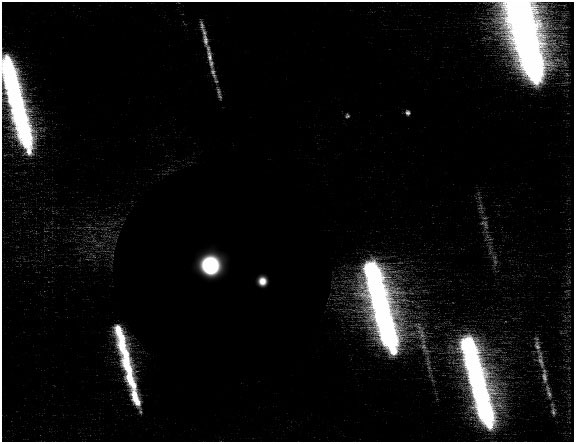New Portrait Made of Pluto and its Moons

New images of Pluto and its moons are among the sharpest ever made, astronomers announced today.
Pluto, long called a planet, was downgraded last year to "dwarf planet" status by the International Astronomical Union. It is so far away that no clear pictures of it exist.
The new images are 20 times brighter than those taken of Pluto 30 years ago when its large moon Charon was discovered. The resulting snapshots are expected to bring astronomers closer to estimating the sizes of Pluto's satellites, Nix, Hydra and Charon.
"Several favorable factors occurred simultaneously to yield these spectacular images of the Pluto system," said astronomer David Tholen, who performed the observations during an early September evening with one of Mauna Kea's twin Keck telescopes.
Tholen relied on the adaptive optics system of Keck, which compensates for turbulence from Earth's atmosphere that typically blurs the light from celestial bodies. In addition, Pluto was at its maximum brightness that night, giving the adaptive optics "stellar" conditions.
He took 16 images of the system and combined them into a single picture, resulting in clear views of Nix and Hydra, Pluto's small satellites that were discovered in 2005 with the Hubble Space Telescope.
"It is our intent to obtain several more images of the Pluto system, hopefully with this same level of quality, so that we can track Nix and Hydra completely around Pluto several times," Tholen said.
Get the Space.com Newsletter
Breaking space news, the latest updates on rocket launches, skywatching events and more!
The sharp images will show precise positions of the satellites, which will allow astronomers to detect tiny displacements caused by their mutual gravitational tugs. The measurements can be translated into more precise masses for Nix and Hydra.
"Once the masses are in hand, we'll be able to say something more definitive about how big these new satellites are," Tholen explained.
Astronomers have estimated that Nix and Hydra are less than 62 miles (100 kilometers) in diameter, compared with 753 miles (1,212 kilometers) for Charon and about 1,429 miles (2,300 kilometers) for Pluto.
The more definitive measurements are important for scientists planning the 2015 flyby of Pluto with NASA's New Horizons spacecraft. "Something as simple as selecting the proper exposure time to snap images of Nix and Hydra with New Horizons depends on knowing how big they are and how reflective their surfaces are," Tholen said. "One of our goals is to have those answers well in advance of the flyby."
- Video: Planet Hunter
- Top 10 Most Intriguing Extrasolar Planets
- Image Gallery: The New Solar System
Join our Space Forums to keep talking space on the latest missions, night sky and more! And if you have a news tip, correction or comment, let us know at: community@space.com.

Space.com is the premier source of space exploration, innovation and astronomy news, chronicling (and celebrating) humanity's ongoing expansion across the final frontier. Originally founded in 1999, Space.com is, and always has been, the passion of writers and editors who are space fans and also trained journalists. Our current news team consists of Editor-in-Chief Tariq Malik; Editor Hanneke Weitering, Senior Space Writer Mike Wall; Senior Writer Meghan Bartels; Senior Writer Chelsea Gohd, Senior Writer Tereza Pultarova and Staff Writer Alexander Cox, focusing on e-commerce. Senior Producer Steve Spaleta oversees our space videos, with Diana Whitcroft as our Social Media Editor.









